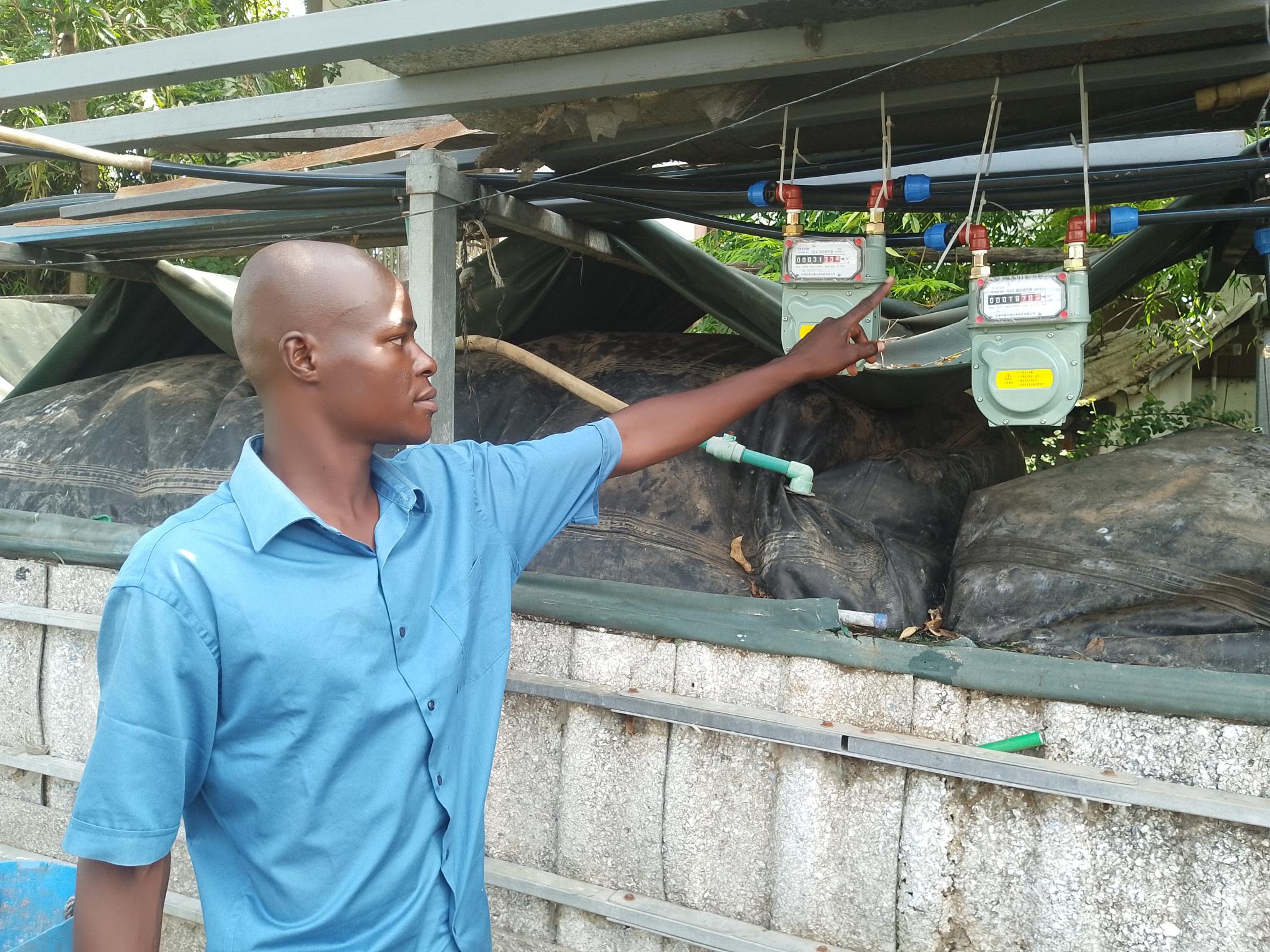

The lush trees lining the CBD reflect the county government’s efforts to restore greenery and promote sustainability in the region.
The air is fresh, and the streets are quiet, a peaceful prelude to the inspiring story we are about to uncover.
After a 10-minute drive toward the lake, we arrive at Dunga beach, a serene yet bustling hub where tourism, community and innovation intersect.
Here, a quiet revolution is unfolding, one where organic waste becomes clean energy and solar power replaces smoky fires.
We are received by Hesbon Owino, an ornithologist with Friends of Dunga Swamp, a community-based organisation dedicated to conservation and eco-tourism.
Hesbon is busy cleaning the area, preparing for another day of hosting tourists, who come for zip-lining and bird-watching along Lake Victoria’s shores.
“Tourism is growing here, but so is waste,” Hesbon says as he picks up a discarded plastic bottle. “That’s why we’re not just focused on attracting visitors but also ensuring our activities don’t harm the environment.”
His words set the stage for
what becomes more than a tourism experience; it’s a deep dive into how
sustainability is reshaping lives in this lakeside community.
This is Lake Victoria in the age of reinvention, a 68,800km² freshwater ecosystem spanning three nations.
Here sustainability is no longer abstract policy but a daily practice embraced by fishing communities, researchers and policymakers alike.
HYACINTH HEADACHE
Just 50m from where Hesbon Okoth collects plastic bottles along the bird watching trails, we find Geoffrey Omondi crouched beside a bubbling biogas digester.
The short walk between their workspaces traces Dunga Beach’s sustainability revolution in microcosm.
Geoffrey Omondi of Flexi Biogas kneels beside a swollen polyethylene digester filled with fish offal and food scraps.
“This is just one part of our operations nationwide,” Geoffrey says, wiping his hands on a cloth.
“We’ve established a complete waste-to-value chain here.”
His team collects organic waste from hotels and restaurants using specialised containers provided free to businesses.
“After collection, we sort meticulously. Only about 45 per cent goes into digesters; the rest is taken to farms as fertiliser, while solid waste like broken glass is sold to recycling companies.”
The operation ingeniously tackles one of Lake Victoria’s biggest challenges: water hyacinth.
“We harvest about 200kg weekly,” Geoffrey says, patting a bale of the invasive plant destined for a digester.
“It’s perfect feedstock:
abundant, free, and we’re cleaning the lake in the process.”
“We’ve built an integrated system where nothing is wasted. Fish offal that once polluted the lake now powers clean stoves, solar-dried omena prevents spoilage, and water hyacinth becomes biogas feedstock.
“Nutrient-rich byproducts fertilise nearby farms instead of chemicals. This closed-loop approach shows how ecological solutions can meet community needs: reducing deforestation, improving air quality and protecting the lake for future generations.”
BIOGAS BONANZA
Geoffrey opens a tap on the digester, filling a jerrycan with liquid biofertiliser.
“Farmers report 30 per cent higher yields compared to chemical fertilisers. We’re not just making energy, we’re rebuilding soil health.”
The system’s impact extends further. Hotels save on waste disposal, farmers gain affordable inputs and fishers access reliable processing.
“We’ve created several permanent jobs here,” Geoffrey says. “But the real victory? Proving environmental solutions can be profitable.”
As dusk falls, biogas lamps flicker to life across Dunga beach. These small lights illuminate a big idea: Lake Victoria’s salvation may come not from aid but from innovation that makes sustainability pay.
For Eunice Anyango, the
impact is measured in shillings and seconds.
“Biogas cooks twice as fast as charcoal, and my profits have doubled,” she says, flipping omena on a smokeless burner.
The health benefits are profound. WHO research shows biogas reduces indoor air pollution by 90 per cent, a critical improvement for lakeside communities, where respiratory diseases account for nearly 20 per cent of adult medical visits.
Women and children, who spend the most time near cooking areas, benefit the most.
The environmental impact is equally significant.
A 2023 FAO report found
that scaling this model across Lake Victoria could convert 200,000 metric
tonnes of annual fish waste into 50 million cubic meters of renewable gas,
while reducing nitrogen loading by 12 to 15 per cent.
This dual benefit offers a replicable model for freshwater ecosystems worldwide.
The circular design delivers compounding benefits: slashing indoor particulate matter to WHO- levels, protecting aquatic ecosystems, mitigating climate change through methane capture and creating green jobs.
This demonstrates how integrated solutions can simultaneously advance health, ecology and socioeconomics.
This approach addresses SDGs 3 (Good Health), 6 (Clean Water), 7 (Affordable Energy), and 13 (Climate Action).
Thus, it proves how community-scale technology can create cascading positive impacts.
NO DIRT OR WASTE
The sustainability journey does not end at biogas. Nearby, a solar-powered fish drier hums under the Kisumu sun, transforming how women preserve their catch.
While biogas tackles waste and clean energy, solar drying addresses post-harvest losses and food safety, which are complementary pillars of Dunga beach’s green revolution.
Mary Didi adjusts her hat as she turns a tray of omena in the solar drier.
“The fisheries department and partners changed our lives with this technology,” she says.
“Before, we lost whole days to rain. Now, our omena dries evenly. No contamination, no waste. Customers pay more for clean fish, and my children eat better.”
As she loads a fresh batch, Rose notes the stainless steel mesh, a WHO-recommended material for minimising contamination.
Nearby, a fisheries officer records drying times for a FAO-monitored project.
For Rose, the data confirms what she sees daily: her omena emerges perfectly dried, safe and ready to sell, come rain or shine.
Dunga beach’s story proves that environmental and economic challenges can be tackled through innovative, community-driven solutions.
By converting fish waste into biogas and adopting solar drying for omena, this lakeside village has not only reduced pollution but also created new opportunities for growth. What began as an effort to clean Lake Victoria has blossomed into a model of circular economy, one where waste is no longer a burden but a resource.
This transformation demonstrates that sustainability is not just an ideal but a practical pathway to resilience.
Critically, the success of these solutions lies in their integration. The biogas digesters and solar driers work in tandem, addressing multiple problems simultaneously: waste management, clean energy access, food security and public health.
Women like Eunice Anyango and Mary Didi are at the heart of this change, proving that when marginalised groups are empowered with the right tools, entire communities thrive.
The data speaks for itself: 90 per cent less indoor air pollution, 60 per cent fewer post-harvest losses and a 30 per cent increase in crop yields from bio fertilisers.
These numbers validate what the residents already know: systemic change is possible.
The lessons from Dunga beach extend far beyond Lake Victoria.
Policymakers, development agencies and other fishing communities can replicate this model, adapting it to local contexts.
The key ingredients?
Appropriate technology, community ownership and a commitment to turning
problems into opportunities.
As climate change intensifies and global waste crises grow, solutions like these offer a roadmap for balancing ecological health with human prosperity.
Ultimately, Dunga beach’s journey is a testament to the power of ingenuity and collective action. It challenges the narrative that environmental progress must come at the expense of economic growth.
Instead, it shows how the two can reinforce each other.
As the sun sets over Lake Victoria, the glow of biogas lamps and the sight of perfectly dried omena in solar tents are more than just signs of progress; they are beacons of hope for a sustainable future.
The question now is not whether such solutions work, but how quickly they can spread.











